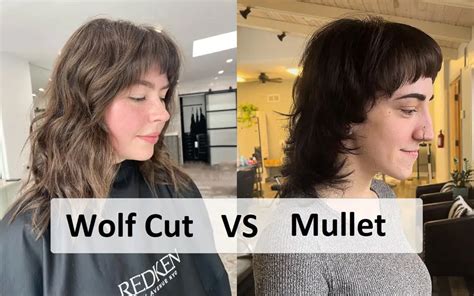Introduction
In the realm of hair fashion, two enigmatic styles have emerged to capture the hearts of hair enthusiasts: the wolf cut and the mullet. While both share certain similarities, they possess distinct characteristics that set them apart. This comprehensive guide delves into the depths of these two iconic hairstyles, providing an in-depth analysis of their differences and similarities, leaving you with an informed decision for your next hair transformation.

Wolf Cut: A Wolf in Sheep’s Clothing
The wolf cut, a hybrid of the shag and the mullet, made its triumphant return in 2022, captivating the fashion world with its edgy and versatile allure. Characterized by its choppy layers, face-framing fringe, and voluminous crown, the wolf cut defies convention and embraces individualism. Its name playfully captures the essence of the style – a combination of the wolf’s untamed spirit and the sheep’s innocent charm.
Mullet: A Throwback to the ’80s
The mullet, an iconic hairstyle that dominated the ’80s, has made a surprising resurgence in recent years. Known for its distinctive “business in the front, party in the back” approach, the mullet is a polarizing style that either evokes nostalgia or bewilderment. With its short, layered front and long, flowing back, the mullet exudes an undeniable retro vibe, making it a favorite among those who embrace unconventional fashion choices.
Similarities and Differences: A Tale of Two Haircuts
Similarities:
- Layered construction: Both wolf cuts and mullets feature layered haircuts, creating volume and texture.
- Edgy aesthetic: These styles challenge traditional hair norms and embrace an unconventional, edgy look.
- Versatility: Wolf cuts and mullets can be customized to suit different face shapes and hair types, making them adaptable to various styles.
Differences:
- Length: Mullets maintain a distinct asymmetry, with short, cropped hair in the front and longer hair in the back, while wolf cuts typically feature a more balanced length throughout.
- Volume: Wolf cuts emphasize volume, particularly at the crown, creating a fuller and shaggier appearance. Mullets, on the other hand, focus on volume in the back, resulting in a more elongated silhouette.
- Fringe: Wolf cuts often incorporate a face-framing fringe, adding extra definition and style. Mullets, in contrast, tend to avoid fringes and maintain a clean cut in the front.
The Wolf Cut vs Mullet Debate: Which One Is Right for You?
The choice between a wolf cut and a mullet ultimately depends on your personal style and preferences. Consider the following factors:
- Face Shape: Wolf cuts flatter oval, heart, and diamond face shapes, while mullets suit square and round faces.
- Hair Type: Wolf cuts are suitable for thick, wavy, or curly hair, while mullets perform best on straight or slightly wavy hair.
- Lifestyle: Wolf cuts require regular styling to maintain their shape and volume, whereas mullets are relatively low-maintenance, making them ideal for busy individuals.
Step-by-Step Guide to Nailing the Wolf Cut or Mullet
Wolf Cut:
- Start with damp, detangled hair.
- Section off the top layer of hair and secure it with a clip.
- Divide the bottom layer into small sections and use a razor comb to cut choppy, layered pieces.
- Repeat step 3 for the top layer.
- Create a face-framing fringe by cutting shorter layers around the hairline.
- Thin out the layers as needed to reduce bulk and enhance texture.
Mullet:
- Section off the front and back of the hair.
- Cut the front hair short, layering it slightly to create volume.
- Leave the back hair long and layered, blending the layers into the front for a seamless transition.
- Avoid cutting the back hair too short, as it will create a “hockey stick” effect.
- Trim the sides of the back hair to shape the mullet.
Tips and Tricks for Wolf Cut and Mullet Styling
- Wolf Cut: Use a volumizing mousse or texturizing spray to boost volume at the roots. Enhance the fringe with a light-hold setting spray to keep it in place.
- Mullet: Embrace the messy, undone look by using dry shampoo to add texture and volume. Experiment with braiding or tying up the back hair to create different styles.
Common Mistakes to Avoid
- Wolf Cut: Avoid over-layering, which can create a choppy and uneven appearance. Over-thinning can also lead to a loss of volume and texture.
- Mullet: Ensure a smooth transition between the short front and long back. Avoid cutting the back hair too short, as this can create an extreme and unflattering contrast.
Conclusion
The wolf cut and mullet, two distinct yet captivating hairstyles, continue to captivate hair enthusiasts worldwide. By understanding their similarities and differences, you can make an informed decision about which style best suits your personal style and hair type. Whether you opt for the edgy glamour of the wolf cut or the nostalgic charm of the mullet, embrace the transformative power of these iconic hairstyles and unleash your inner fashionista.
